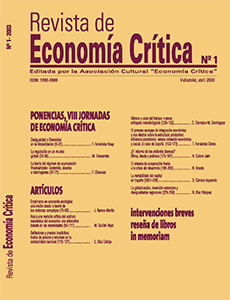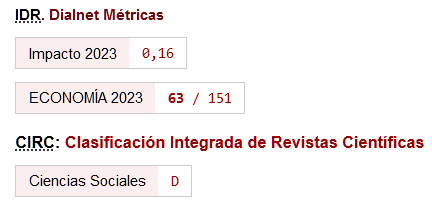Género y usos del tiempo: nuevos enfoques metodológicos
Palabras clave:
concepto de tiempo, uso del tiempo, desigualdades de géneroResumen
En las últimas décadas, los estudios sobre uso del tiempo han tenido cada vez más importancia. Disponer de información acerca de cómo mujeres y hombres distribuyen su tiempo, entre las distintas actividades a lo largo del día, ha permitido tener una visión más completa y real de la organización social del tiempo y de las diferencias por sexo y otras variables significativas (edad, tipología familiar, etc.). En este artículo se plantea, en primer lugar, un concepto de tiempo que supera la visión estrecha que maneja habitualmente la economía, reconociendo los tiempos que caen fuera de la órbita mercantil. A continuación se discuten las posibilidades metodológicas de un estudio sobre uso del tiempo, realizado en conjunto, con una encuesta sobre trabajo en la ciudad de Barcelona. El objetivo es realizar análisis específicos -poco habituales en este tipo de estudios- en relación a la tipología de hogar, la simultaneidad de actividades, el tiempo de cuidados y el uso del tiempo por franjas horarias. Los resultados muestran la potencialidad de esta metodología para el análisis de la actividad de mujeres y hombres, aunque también se señalan sus limitaciones. Estas guardan relación con la falta de información sobre los aspectos más subjetivos del tiempo que, sin embargo, contribuyen de manera significativa a las desigualdades de género.
Descargas
Citas
Adams, B. (1999): "Cuando el tiempo es dinero. Racionalidades del tiempo y desafíos a la teoría y práctica del trabajo", Sociología del Trabajo, 37, otoño.
Becker, G. (1964): Human Capital, NBER, Nueva York.
Becker, G. (1981): A Treatise on the Family, Harvard University Press.
Bonke, J. (1995): "Los conceptos de trabajo y de cuidado y atención: una perspectiva económica", Política y Sociedad, 19.
Borderías; C, Carrasco: C y Alemany, C. (1994): Las mujeres y el trabajo. Rupturas conceptuales, Fuhem-Icaria.
Carrasco, C. (1991): El trabajo doméstico. Un análisis económico, Ministerio de Trabajo y Seguridad Social, Colección Tesis Doctorales, Madrid.
Del Re, A. (1995): "Tiempo de trabajo asalariado y tiempo del trabajo de reproducción", Política y Sociedad, 19.
Durán, M.A. (1988): De puertas adentro, Serie Estudios, 12, Instituto de la Mujer, Madrid.
Durán, M.A. (1991): "El tiempo en la economía española" ICE, 695.
European Commission, Employment and Social Affairs (1998): Flexible working and the reconciliation of work and family life or a new form of precariouness, Bruselas.
Floro (1995): "Women's Well-Being, Poverty and Work Intensity", Feminist Economics, 1(3).
https://doi.org/10.1080/714042246
Folbre, N. (1994): Who Pays for the Kids? Routledge. London and New York. https://doi.org/10.4324/9780203168295
Gershuny, J. y Jones, S. (1987): Time Use in Seven Countries, Dublin, European Foundation.
Himmelweit, S. (1995): The Discovery of "Unpaid Work": The Social Consequences of the Expansion of "Work". Feminist Economics, 1(2). https://doi.org/10.1080/714042229
Mincer, J. (1962): "Labor Force Participation of Married Women: A Study of Labor Supply" en Aspects of Labor Economics, Lewis (ed.), NBER, Princeton University Press.
Murillo, S. (2001): "Pacto social o negociación entre géneros en el uso del tiempo laboral" en C. Carrasco (2001) (ed.): Tiempos, trabajos y género, Publicacions Universitat de Barcelona, Nº 10.
Schultz, T.W. (1961): "Investment in Human Capital", American Economic Review, vol. 51.
Schultz, T.W. (1968): Valor económico de la educación, Uteha, México (e.o. 1963).
Szalai, A. (1972): The Use of Time, Mouton, The Hague-Paris.
Thompson, E.P. (1967): "Work, time-discipline and industrial capitalism", Past and Present, 38.
https://doi.org/10.1093/past/38.1.56
Torns, T. (2001): "El tiempo de trabajo de las mujeres: entre la invisibilidad y la necesidad" en C. Carrasco (2001) (ed.): Tiempos, trabajos y género, Publicacions Universitat de Barcelona, 10.
Vantaggiato, I. (2001) "El tiempo que me queda". Relación entre el tiempo de la necesidad y el de la libertad" en A. Buttarelli et al., Una revolución inesperada. Simbolismo y sentido del trabajo de las mujeres, Narcea.
Descargas
Publicado
Cómo citar
Número
Sección
Licencia
Esta licencia permite a terceros compartir (copiar y redistribuir el material en cualquier medio o formato) y adaptar (remezclar, transformar y crear a partir del material para cualquier finalidad, incluso comercial), siempre que se reconozca la autoría y la primera publicación en esta revista (La Revista, DOI de la obra), se proporcione un enlace a la licencia y se indique si se han realizado cambios en la obra.







